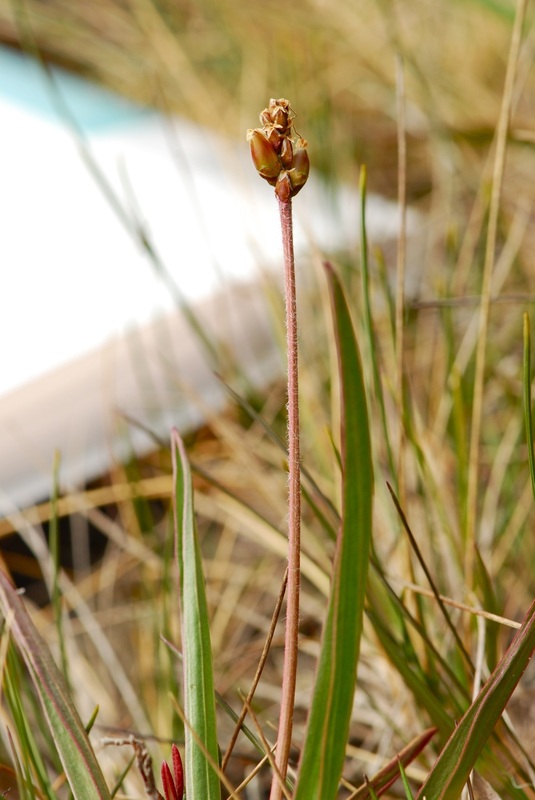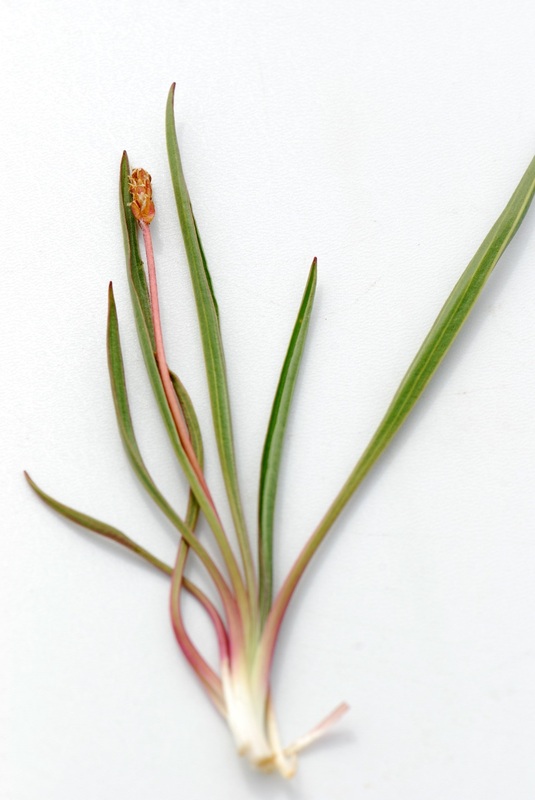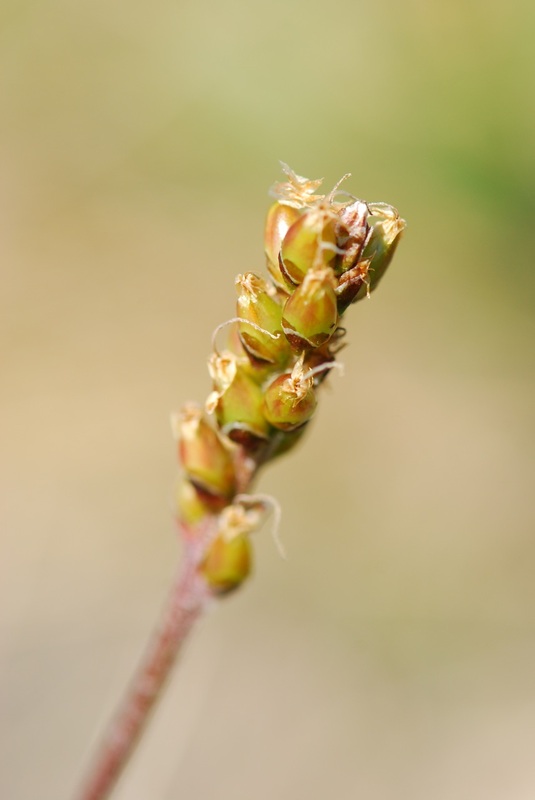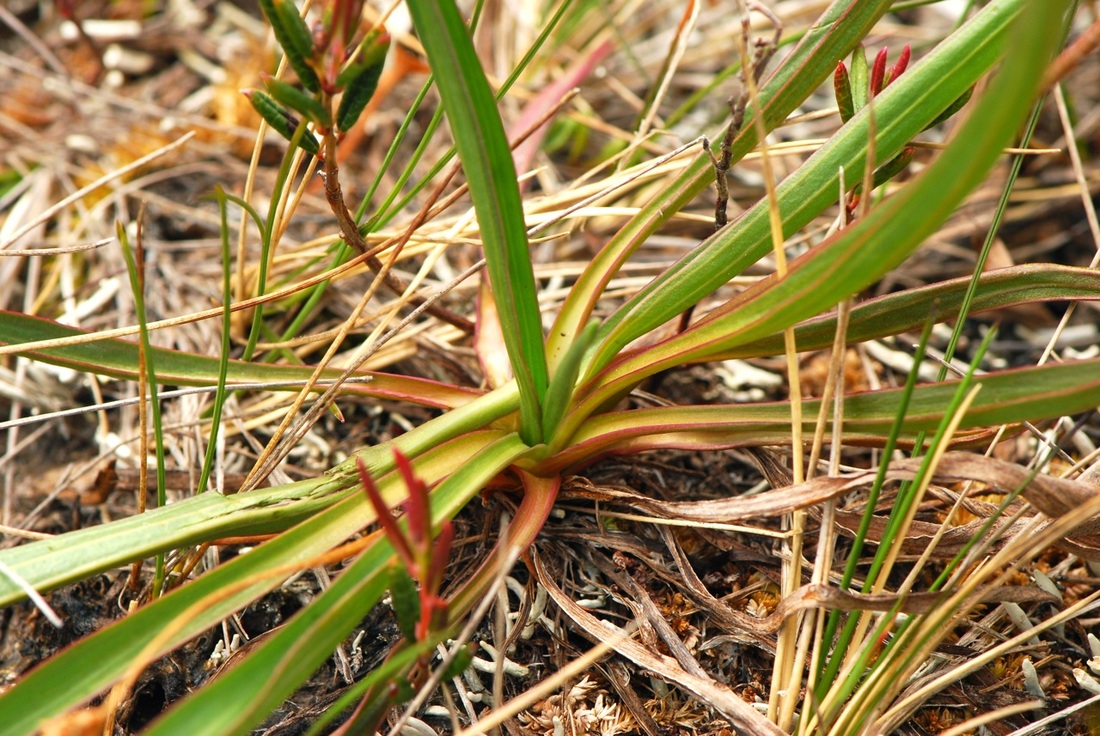Alaska plantain, seashore plantain • Plantago macrocarpa
Identification
Alaska plantain is a perennial plant with very small greenish-brownish flowers. These lobe-shaped flowers are composed of four fused petals. They grow in spikes that are short and dense during flowering but then expand and loosen when mature. The fruits, pictured above, are egg-shaped capsules. Alaska plantain has non-fleshy, smooth basal leaves and no stem leaves. The basal leaves are long and lance-shaped, with several veins, narrow bases, and distinct stalks. Alaska plantain grows from a thick taproot.
Habitat & Range
Alaska plantain grows in moist to wet meadows, shorelines, tidal marshes, and bogs at low elevations. It is a coastal species and is common from the Central Coast to southern Alaska. It is less frequent from the south coast of BC to Oregon. Alaska plantain also grows in coastal habitats of eastern Asia.
Similar Species
Seaside plantain (Plantago maritima), a similar coastal species, can be distinguished from Alaska plantain by its thinner linear leaves that lack the distinct stalks of Alaska plantain. Mature plants can be differentiated by their seed capsules - those of Alaska plantain are large and unopened at maturity, while sea plantain seed capsules open up along a midline.
Alaska plantain is a perennial plant with very small greenish-brownish flowers. These lobe-shaped flowers are composed of four fused petals. They grow in spikes that are short and dense during flowering but then expand and loosen when mature. The fruits, pictured above, are egg-shaped capsules. Alaska plantain has non-fleshy, smooth basal leaves and no stem leaves. The basal leaves are long and lance-shaped, with several veins, narrow bases, and distinct stalks. Alaska plantain grows from a thick taproot.
Habitat & Range
Alaska plantain grows in moist to wet meadows, shorelines, tidal marshes, and bogs at low elevations. It is a coastal species and is common from the Central Coast to southern Alaska. It is less frequent from the south coast of BC to Oregon. Alaska plantain also grows in coastal habitats of eastern Asia.
Similar Species
Seaside plantain (Plantago maritima), a similar coastal species, can be distinguished from Alaska plantain by its thinner linear leaves that lack the distinct stalks of Alaska plantain. Mature plants can be differentiated by their seed capsules - those of Alaska plantain are large and unopened at maturity, while sea plantain seed capsules open up along a midline.
References
Plantago macrocarpa Cham. & Schltdl. In Klinkenberg, Brian. (Ed.). E-Flora BC: Electronic Atlas of the Plants of British Columbia. Lab for Advanced Spatial Analysis, Department of Geography, University of British Columbia, Vancouver. Accessed 09/07/2014.
Pojar, J. and MacKinnon, A. (1994). Plants of Coastal British Columbia. Vancouver, BC: Lone Pine Publishing. P. 329.
Authors and editors of page
Kelly Fretwell and Brian Starzomski (2014).
Plantago macrocarpa Cham. & Schltdl. In Klinkenberg, Brian. (Ed.). E-Flora BC: Electronic Atlas of the Plants of British Columbia. Lab for Advanced Spatial Analysis, Department of Geography, University of British Columbia, Vancouver. Accessed 09/07/2014.
Pojar, J. and MacKinnon, A. (1994). Plants of Coastal British Columbia. Vancouver, BC: Lone Pine Publishing. P. 329.
Authors and editors of page
Kelly Fretwell and Brian Starzomski (2014).







